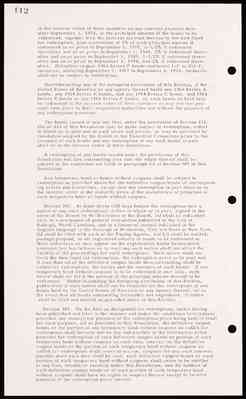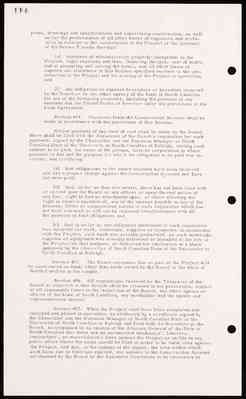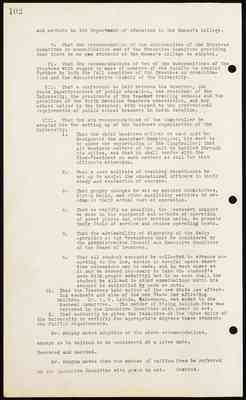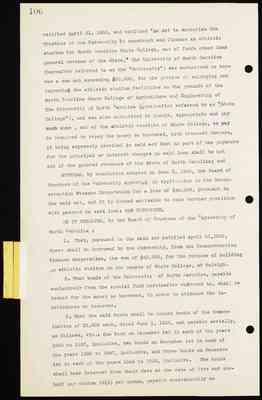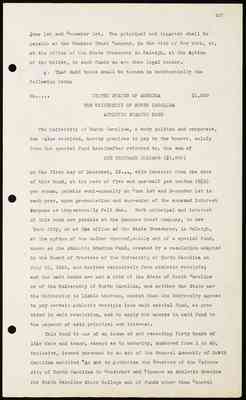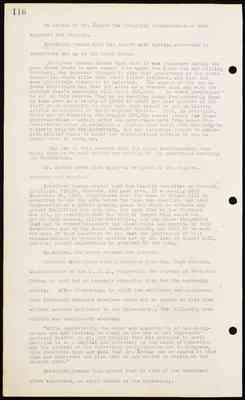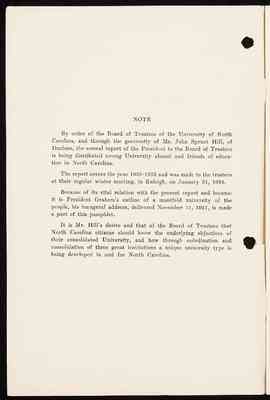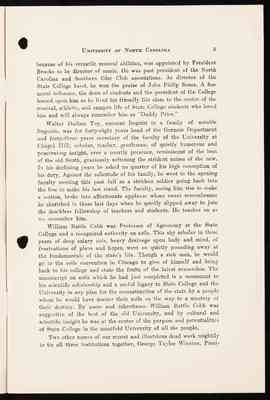Pages That Need Review
Volume 09: June 17, 1964–February 28, 1966
112
in the inverse order of their numbers on any interest payment date after September 1, 1974, at the principal amount of the bonds to be redeemed, together with the interest accrued thereon to the date fixed for redemption, plus a premium of 3% of such principal amount if redeemed on or prior to September 1, 1979, 2-1/2% if redeemed thereafter and on or prior to September 1, 1984, 2% if redeemed thereafter and on or prior to September 1, 1989, 1-1/2% if redeemed thereafter and on or prior to September 1, 1994, and 1% if redeemed thereafter. Definitive coupon 1964 Series F bonds numbered 1-F to 253-F, inclusive, maturing September 1, 1967 to September 1, 1974, inclusive, shall not be subject to redemption.
Notwithstanding any of the foregoing provisions of this Section, if the United States of America or any agency thereof holds any 1964 Series A bonds, any 1964 Series E bonds, and any 1964 Series C bonds, and 1964 Series E bonds or any 1964 Series F bonds, all such bonds so held may be redeemed in the inverse order of their numbers on any interest payment date prior to their respective maturities and without the payment of any redemption premium.
The bonds issued at any one time under the provisions of Section 211, 212 or 213 of this Resolution may be made subject to redemption, either in whole or in part and at such times and prices, as may be provided by resolution adopted by the Board or the Executive Committee prior to the issuance of such bonds and any redemption of any such bonds in part shall be in the inverse order of their maturities.
A redemption of any bonds issued under the provisions of this Resolution and then outstanding less than the whole thereof shall be subject to the conditions set forth in paragraph (c) of Section 507 of this Resolution.
Any temporary bond or bonds without coupons shall be subject to redemption as provided above for the definitive coupon bonds of corresponding series and maturities, except that any redemption in part shall be in the inverse order of the maturity dates of the instalments of principal of such temporary bond or bonds without coupons.
Section 302. At least thirty (30) days before the redemption date a notice of any such redemption, either in whole or in part, signed in the name of the Board by the Secretary of the Board, (a) shall be published once in a newspaper of general circulation published in the City of Raleigh, North Carolina, and in a financial journal published in the English language in the Borough of Manhattan, City and State of New York, (b) shall be filed with each of the Paying Agents, aid (c) shall be mailed, postage prepaid, to all registered owners of bonds to be redeemed at their addresses as they appear on the registration books hereinabove provided for; but failture so to mail any such notice shall not affect the validity of the proceedings for such redemption. Such notice shall set forth the date fixed for redemption, the redemption price to be paid and, if less than all of the definitive coupon bonds then outstanding shall be called for redemption, the series and the numbers of such bonds. If any temporary bond without coupons is to be redeemed in part only, such notice shall set forth the portion of the principal amount thereof to be redeemed. Notwithstanding the foregoing provisions of this Section, publication of such notice shall not be required for the redemption of any bonds held by the United States of America or any agency thereof, or in the event that all bonds outstanding hereunder are registered, if notice shall be filed and mailed as provided above in this Section.
Section 303. On the date so designated for redemption, notice having been published and filed in the manner and under the conditions hereinabove provided and moneys for payment of the redemption price being held in trust for such purpose, all as provided in this Resolution, the definitive coupon bonds or the portion of any temporary bond without coupons so called for redemption shall become and be due and payable at the redemption price provided for redemption of such definitive coupon bonds or portion of such temporary bond without coupons on such date, interest on the definitive coupon bonds or the portion of such temporary bond without coupons so called for redemption shall cease to accrue, coupons for any such interest payable after such date shall be void, such definitive cioupon bonds or such portion of such temporary bond without coupons shall cease to be entitled to any lien, benefit or security under this Resolution, and the holders of such definitive coupon bonds or of such portion of such temporary bond without coupons shall have no rights in respect thereof except to receive payment of the redemption price thereof.
114
plans, drawings and specifications and supervising construction, as well as for the performance of all other duties of engineers and architects in relation to the construction of the Project or the issuance of the Series F bonds therefor;
(e) expenses of administration properly chargeable to the Project, legal expenses and fees, financing charges, cost of audits and of preparing and issuing the bonds, and all other items of expense not elsewhere in this Section specified incident to the construction of the Project and the placing of the Project in operation; and
(f) any obligation or expense heretofore or hereafter incurred by the Board or by any other agency of the State of North Carolina for any of the foregoing purposes, including the payment of any amounts due the United States of America under the provisions of the Loan Agreement.
Section 404. Payments from the Construction Account shall be made in accordance with the provisions of this Section.
Before payment of any item of cost shall be made by the Board, there shall be filed with the Treasurer of the Board a requisition for such payment, signed by the Chancellor and the Business Manager of North Carolina State of the University of North Carolina at Raleigh, stating each amount to be paid, the name of the person, firm or corporation to whom payment is due and the purpose for which the obligation to be paid was incurred, and certifying:
(a) that obligations in the stated amounts have-been incurred and are a proper charge against the Construction Account and have not been paid;
(b) that, so far as they are aware, there has not been filed with or served upon the Board or any officer or agent thereof notice of any lien, right to lien or attachment upon, or claim affecting the right to receive payment of, any of the moneys payable to any of the persons, firms or corporations named in such requisition which has not been released or will not be released simultaneously with all the payment of such obligation; and
(c) that in so far as any obligation mentioned in such requisition was incurred for work, materials, supplies or equipment in connection with the Project, such work was actually performed, or such materials, supplies or equipment was actually delivered or installed at the site of the Project for that purpose, or delivered for fabrication at a place approved by the Chancellor of North Carolina State of the University of North Carolina at Raleigh.
Section 405. The Board covenants that no part of the Project will be constructed on lands other than lands owned by the Board or the State of North Carolina in fee simple.
Section 406. All requisitions received by the Treasurer of the Board as required in this Article shall be retained in his possession, subject at all reasonable times to the inspection of the Board, any other agency or officer of the State of North Carolina, any bondholder and the agents and representatives thereof.
Section 407. When the Project shall have been completed and equipped and placed in operation, as evidenced by a certificate signed by die Chancellor and the Business Manager of North Carolina State of the University of North Carolina at Raleigh and filed with the Secretary of the Board, accompanied by an opinion of the Attorney General of the State of North Carolina that there are no uncancelled mechanics', laborers', contractors', or materialmen's liens against the Project or on file in any public office where the same should be filed in order to be valid liens against the Project, and that, in the opinion of the signer, the time within which such liens can be filed has expired, any balance in the Construction Account not deemed by the Board or the Executive Committee to be necessary to
11/16/64 - Reg. B/T
87
Library Lecture Room Campus of the University of North Carolina at Greensboro November 16, 1964
The Board of Trustees of The University of North Carolina met in regular session on the Greensboro campus of the University at 11:00 o'clock, A. M., on Monday, November 16, 1964; Arch T. Allen, Secretary.
In the absence of Governor Sanford, Mr. Frank Parker was elected to preside.
The meeting was opened with prayer by Mr. Thomas O. Moore.
On roll call the following members answered present:
Dr. Francis A. Buchanan Dr. Jesse B. Caldwell Lenox G. Cooper Marshall Y. Cooper W. Lunsford Crew Calvin Graves Mrs. A. H. Lathrop Dr. John G. Mebane Larry I. Moore Arthur I. Park Thomas J. Pearsall Clarence L. Pemberton Mrs. L. Richardson Preyer H. L. Riddle, Jr. Roy Rowe C. Lacy Tate W. Frank Taylor F. E. Wallace Cameron S. Weeks Mrs. George D. Wilson Arch T. Allen Mrs. Ed M. Anderson Ike F. Andrews William C. Barfield Mrs. J. W. Copeland Frank Hull Crowell Dr. Rachel Davis Percy B. Ferebee Robert Hall William B. Harrison Mack Jernigan Ernest E. Parker, Jr. Frank Parker Claude W. Rankin T. Henry Redding William P. Saunders Evander S. Simpson
Dr. Shahane R. Taylor Thomas B. Upchurch, Jr. C. M. Vanstory, Jr. Hill Yarborough Wade Barber Graham W. Bell Victor S. Bryant Henry A. Foscue W. C. Harris, Jr. Mrs. J. B. Kittrell J. Hanes Lassiter John Lassiter John Van Lindley Reid A. Maynard William C. Medford Mrs. S. L. Rodenbough A. Alex Shuford Ben C. Trotter Oscar C. Vatz Fred L. Wilson Irwin Belk T. J. Collier James C. Farthing Dr. Dorothy Glenn George Watts Hill Mrs. J. Henry Hill, Jr. Thomas H. Leath W. J. Lupton Thomas McKnight D. L. McMichael R. D. McMillan, Jr. Thomas O. Moore Ashley M. Murphy Douglas M. Robinson R. Glenn Stovall Dr. David T. Tayloe Macon M. Williams
The following members were absent:
Wilbur H. Currie James L. Pittman John P. Stedman Bowman Gray Herbert Hardy G. N. Noble Walter L. Smith Luther Hamilton Robert B. Jordan, III R. Walker Martin C. Knox Massey W. A. Johnson
William G. Reid B. Atwood Skinner Dr. L. H. Swindell J. Shelton Wicker Wyatt R. Aydlett Mrs. Mebane H. Burgwyn S. N. Clark, Jr. Archie K. Davis Rudolph I. Mintz Carl V. Venters Henry Weil George M. Wood Charles F. Carroll, member ex-officio
Volume 01: July 11, 1932–July 8, 1938
102
and methods in the department of education in the Woman's College,
V. That the recommendation of the subcommittee of the Trustees committee on consolidation and of the Executive Committee providing that there be no man students at the Womanis College be adopted.
VI. That the recommendations of two of the subcommittees of the Trustees with regard to ages of members of the faculty be studied further by both the full committee of the Trustees on consolidation and the Administrative Council of the University.
VII. That a conference be held between the Governor, the State Superintendent of public education, the President of the University, the presidents of the teacher training schools and the president of the North Carolina Teachers association, and any others called by the Governor, with regard to the professional requirements of public school teachers in North Carolina.
VIII. That the six recommendations of the Comptroller be adopted for the setting up of the business organization of the University:
1. That the chief business officer at each unit be designated the Assistant Comptroller, his work to be under the supervision or the Comptroller; that all business matters of the unit be handled through his office, and that he shall confer with the Vice-President on such matters as call for that officers attention.
2. That a cost analysis of teaching departments be set up to assist the educational officers in their study and evaluation of courses.
3. That proper charges be set up against dormitories, dining halls, and other auxilliary services to arrive at their actual cost of operation.
4. That as rapidly as possible, the necessary changes be made in the equipment and methods of operation of power plants and other service units, to promote their field of service and reduce operating costs.
5. That the advisability of disposing of the dairy operation at the Greensboro unit be considered by the Administrative Council and Executive Committee of the Board of Trustees.
6.
That all student accounts be collected in advance according to the law, except in special cases short time extensions may be made, and in such eases as it may be deemed necessary to take the student's note with proper security; but in no case shall the student be allowed to stand examinations until his account is satisified by cash or note. IX. That the Trustees take notice of the new State law affecting escheats and also of the new State law affecting tuition. Mr. R. E. Little, Wadesboro, was added to the Escheat Committee. The matter of fixing tuition fees was referred to the Executive Committee with power to act. X. That authority be given the faculties of the three units of the University to certifiy for appropriate degrees these students who fulfill requirements.
Mr. Murphy moved adoption of the above recommendations, except as to tuition to be considered at a later date. Seconded and carried.
Mr. Mangum moved that the matter of tuition fees be referred to the Executive Committee with power to act. Carried.
106
ratified April 21, 1933, and entitled "An Act to Authorize the Trustees of the University to construct and finance an athletic stadium for North Carolina State College, out of funds other than general revenue of the State," The University of North Carolina (hereafter referred to as the "University") was authorized to borrow a sum not exceeding $50,000, for the purpose of enlarging and improving the athletic stadium facilities on the grounds of the North Carolina State College of Agriculture and Engineering of The University of North Carolina (hereinafter referred to as "State College"), and was also authorized to pledge, appropriate and pay such sums , out of the athletic receipts of State College, as may be required to repay the money so borrowed, with interest thereon, it being expressly provided in said act that no part of the payments for the principal or interest charges on said loan shall be met out of the general revenues of the State of North Carolina, and
WHEREAS, by resolution adopted on June 3, 1933, the Board of Trustees of the University approved an application to the Reconstruction Finance Corporation for a loan of $40,000, pursuant to the said act, and it is deemed advisable to make furtner provision with respect to said loan: NOW THEREFORE,
BE IT RESOLVED, by the Board of Trustees of the University of North Carolina :
1. That, pursuant to the said act ratified April 21,1933, there shall be borrowed by the University, from the Reconstruction Finance Corporation, the sum of $40,000, for the purpose of building an athletic stadium on the campus of State College, at Raleigh.
2. That bonds of the University of North Carolina, payable exclusively from the special fund hereinafter referred to, shall be issued for the money so borrowed, in order to evidence the indebtedness so incurred.
3. That the said bonds shall be coupon bonds of the denomination of $1,000 each, dated June 1, 1933, and payable serially, as follows, vix.: One bond on December 1st in each of the years 1933 to 1937, inclusive, two bonds on December 1st in each of the years 1938 to 1947, inclusive, and three bonds on December 1st in each of the years 1948 to 1953, inclusive. The bonds shall bear interest from their date at the rate of five and onehalf per centum (5½%) per annum, payable semi-annually on
107
June 1st and December 1st. The principal and interest shall be payable at the Bankers Trust Company, in the City of New York, or, at the office of the State Treasurer in Raleigh, at the option of the holder, in such funds as are then legal tender.
4. That said bonds shall be Issued in substantially the following form:
No..... UNITED STATES OF AMERICA $1,000
THE UNIVERSITY OF NORTH CAROLINA
ATHLETIC STADIUM BOND
The University of North Carolina, a body politic and corporate, for value received, hereby promises to pay to the bearer, solely from the special fund hereinafter referred to, the sum of
ONE THOUSAND DOLLARS ($1,000)
on the first day of December, 19..., with interest from the date
of this bond, at the rate of five and one-half per centum (5½%) per annum, payable semi-annually on June 1st and December 1st in each year, upon presentation and surrender of the annexed interest coupons as they severally fall due. Both principal and interest of this bond are payable at the Bankers Trust Company, in New York City, or at the office of the State Treasurer, in Raleigh, at the option of the holder thereof, solely out of a special fund, known as the Athletic Stadium Fund, created by a resolution adopted by the Board of Trustees of the University of North Carolina on July 10, 1933, and derived exclusively from athletic receipts; and the said bonds are not a debt of the State of North Carolina or of the University of North Carolina, and neither the State nor the University is liable thereon, except that the University agrees to pay certain athletic receipts into said special fund, as provided in said resolution, and to apply the moneys in said fund to the payment of said principal and interest.
This bond is one of an issue of not exceeding forty bonds of like date and tenor, except as to maturity, numbered from 1 to 40, inclusive, issued pursuant to an act of the General Assembly of Notth Carolina entitled "An Act to Authorize the Trustees of the University of North Carolina to Construct and Finance an Athletic Stadium for North Carolina State College out of funds other than General
116
On motion of Mr. Tucker the foregoing recommendations were approved and adopted.
President Graham made his report with special reference to committees set up at the three Units.
President Graham stated that when it was necessary during the past three years to make salary cuts under the State law and failing revenues, the Trustees thought it wise that professors on the Kenan Foundation share alike with their fellow teachers, and take the same percentage reduction in salaries. The amount of the cut on Kenan Professors has been set aside as a reserve fund and with the current year's operation will total $43,000. He asked permission to set up this reserve fund as an Emeritus Kenan Professorship Fund to take over at a salary of $2000 tO $2400 per year members of the staff whose condition is such that they should be put on limited service or relieved of their regular duties. This, in principle, would not be diverting the regular $75,000 annual income for Kenan Professorships - merely using the percentage cuts from Kenan Professor's salaries to establish a pension fund which will not only be a timely help to the University, but may encourage others to extablish similar funds to honor the distinguished service of men no longer able to carry on.
The use of this reserve from the Kenan Professorship Fund would seem to be well within the wording of the provisions covering the Foundation.
Mr. Parker moved that approval be given to the request.
Seconded and carried.
President Graham stated that the Faculty Committee on Grounds, Buildings, Fields, Forests, and Lake Area, in a meeting held September 28, 1933, recommended that the town of Chapel Hill be permitted to use the site below the lake dam overflow, now used temporarily as a public bathing place but which is without any proper facilities for such use, for such time as the Trustees see fit, on condition that the Town of Chapel Hill erect the proper bath houses, toilet facilities, and any other structures that may be deemed necessary for cleanliness and hygiene by this Committee, and by the State Board of Health, and that it be made the duty of this Committee to see that the provisions of this recommendation be properly carried out by the Town of Chapel Hill, and that proper supervision be provided by the town.
On motion, the above request was granted.
Governor Ehringhaus read a telegram from Gen. Hugh Johnson, Administrator of the N.R.A., requesting the release of President Graham to work out an economic education plan for the consuming public. After discussion, in which the sentiment was unanimous that President Graham's services could not be spared at this time without serious detriment to the University , the following resolution was unanimously adopted:
"While appreciating the honor and opportunity of his designation and not desiring to stand in the way of his expressed personal desires to go, yet feeling that his presence in North Carolina is so essential and necessary to the cause of education and the success of the University consolidation now in progress, this Committee does not feel that Dr. Graham can be spared at this time and expresses the wish that he may decide to remain at his present post."
President Graham then stated that in view of the sentiment above expressed, he would remain at the University.
NOTE
By order of the Board of Trustees of the University of North Carolina, and through the generosity of Mr. John Sprunt Hill, of Durham, the annual report of the President to the Board of Trustees is being distributed among University alumni and friends of education in North Carolina.
The report covers the year 1932-1933 and was made to the trustees at their regular winter meeting, in Raleigh, on January 31, 1934.
Because of its vital relation with the present report and because it is President Graham's outline of a manifold university of the people, his inaugural address, delivered November 11, 1931, is made a part of this pamphlet.
It is Mr. Hill's desire and that of the Board of Trustees that North Carolina citizens should know the underlying objectives of their consolidated University, and how through coördination and consolidation of three great institutions a unique university type is being developed in and for North Carolina.
4 REPORT OF THE PRESIDENT
see in our mind's eyes the long line of those who in this and other centuries laid out the ground on which we stand today.
MEMORIALS OF 1933
We recall this morning the faces and spirit of the members of this body who have died in the brief thirty months of your existence as a consolidated board. Committees of trustees have recorded and will record your memorials of the lives and services of these honored, beloved, and lamented members. No word of mine is needed. I simply pause with you and call their names in recognition of their private virtues and public service, and in commemoration of their pioneer work as members of the first consolidated Board of Trustees of the University of North Carolina: C.W. Gold, B.F. Shelton, C.A. Penn, A.J. Connor, J.D. Murphy, A.A. Shuford, J.M. Horner, J.G. Murphy, E.S. Parker, Jr., and R.N. Page.
In the year since our last January meeting we have lost by death from the several faculties, Dr. Eric A. Abernethy, Professors E.C. Branson, P.W. Price, W.D. Toy, and W.B. Cobb.
Eric A. Abernethy, valiant, generous, lovable, was a physician whose ministry of healing carried him across the blasted fields of France as lieutenant colonel in the United States Army Medical Corps. A battle wound, cumulative suffering, and consequent physical misfortune lay back of his resignation and later tragic and lamented death after thirteen years of unsparing work as community and university physician.
Eugene C. Branson was Kenan Professor of Rural SocialEconomics, director of county surveys in many parts of the United States, founder of Know-Your-Own-County clubs and the North Carolina Club, editor of the University News Letter, with its weekly wideflung package of socially disturbing facts and figures, an eloquent evangel of the live-at-home idea for two decades, and the dynamic center of a constantly radiating wave of light out of Chapel Hill that made a campus minister to a commonwealth. He was nationally distinguished as a rural-social-economic philosopher and locally beloved as neighbor, citizen, teacher, and genial spirit, who will always abide to keep us eager to make our civilization in the pattern of his dreams.
P.W. Price, an alumnus of the Lowell Textile School, became assistant in the Textile School at State College in 1918, and in 1925,
UNIVERSITY of NORTH CAROLINA 5
because of his versatile musical abilities, was appointed by President Brooks to be director of music. He was past president of the North Carolina and Southern Glee Club associations. As director of the State College band, he won the praise of John Philip Sousa. A fine moral influence, the dean of students and the president of the College leaned upon him as he lived his friendly life close to the center of the musical, athletic, and campus life of State College students who loved him and will always remember him as "Daddy Price."
Walter Dallam Toy, eminent linguist in a family of notable linguists, was for forty-eight years head of the German Department and forty-three years secretary of the faculty of the University at Chapel Hill; scholar, teacher, gentleman, of quietly humorous and penetrating insight, ever a courtly presence, reminiscent of the best of the old South, graciously softening the strident noises of the new. In his declining years he asked no quarter of his high conception of his duty. Against the solicitude of his family, he went to the opening faculty meeting this past fall as a stricken soldier going back into the line to make his last stand. The faculty, seeing him rise to make a motion, broke into affectionate applause whose sweet remembrance he cherished in those last days when he quietly slipped away to join the deathless fellowship of teachers and students. He teaches on as we remember him.
William Battle Cobb was Professor of Agronomy at the State College and a recognized authority on soils. This shy scholar in these years of deep salary cuts, heavy drainage upon body and mind, of frustrations of plans and hopes, went on quietly pounding away at the fundamentals of the state's life. Though a sick man, he would go to the soils convention in Chicago to give of himself and bring back to his college and state the fruits of the latest researches. The manuscript on soils which he had just completed is a monument to his scientific scholarship and a useful legacy to State College and the University in any plan for the reconstruction of the state by a people whom he would have master their soils on the way to a mastery of their destiny. By name and inheritance William Battle Cobb was suggestive of the best of the old University, and by cultural and scientific insight he was at the center of the purpose and potentialities of State College in the manifold University of all the people.
Two other names of our recent and illustrious dead work mightily to tie all three institutions together, George Tavloe Winston, Presi
